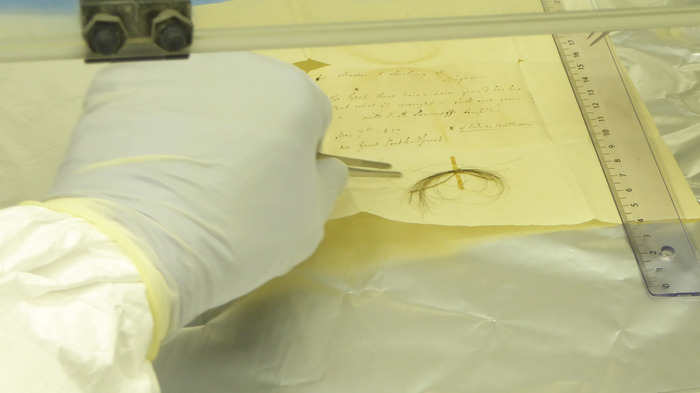Published on
Updated
Reading 4 mins.
More than 200 years after the death of composer Ludwig van Beethoven, a DNA analysis of strands of hair belonging to him probably reveals the cause of his death and possible infidelity. The reason for his deafness, however, still eludes science.
A “cold case” that is nothing classic
To be a subject of science was a wish of Ludwig Van Beethoven himself. In 1802, he made the explicit request to his doctor, JA Schmidt, whom he invited to describe his illness – his progressive hearing loss – to the world, at his death. It’s done 221 years later, at least in part, by an international team that had access to several strands of hair.
In the new study, the team built on recent improvements in the analysis of ancient DNA; these improvements have enabled whole genome sequencing from small amounts of historical hair.
First, they analyzed independently sourced locks of hair attributed to Beethoven, only five of which were confirmed to have come from the same European man. They deemed these five elements to be “almost certainly genuine” and used them to sequence Beethoven’s genome.
The first results were published in the journal Current Biology on March 22.

The causes of his deafness remain mysterious
“Our primary goal was to shed light on Beethoven’s health issues, which include progressive hearing loss, beginning in his mid to late twenties and eventually leading him to become deaf in 1818,” said Johannes Krause of the Max Planck Institute for Evolutionary Anthropology in Leipzig, Germany. Thus, according to the writings, and the assumptions made, hearing loss with tinnitus, excessive perception of sound volume and loss of high frequencies would have ended the career of the composer in his forties.
While expectations were high, no known impairments could be identified in Beethoven’s DNA. The limits linked to the analysis of very old hair mean that the quality of the genetic information collected and the coverage of the genes analyzed remain reduced. Moreover, as many diseases leading to deafness do not yet have an identified genetic marker, it is difficult to come to a conclusion. “In the future, other disease-related genes could be identified and searched for in Beethoven’s genome.“, hopes Johannes Krause.
The hypothesis of cirrhosis is the most probable
What were the circumstances of the composer’s death? This is the second question the researchers wanted to answer. We already knew that Beethoven was suffering from liver disease, the first symptoms of which appeared six years before his death since he described them himself. Heavy alcohol consumption could suggest cirrhosis. The supposition is supported by DNA analysis since it detected a genetic predisposition for liver disease, in particular through the PNPLA3 gene. Another clearly identifiable genetic imprint also appeared in one of the locks of hair: that of the hepatitis B virus, the most severe complication of which is precisely cirrhosis of the liver.
“Liver disease could be due to the interaction between alcohol consumption, the hepatitis B virus and a genetic predisposition“, therefore concludes Markus M. Nöthen, co-author of the new study.
“We discovered a number of important genetic risk factors for liver disease. We also found evidence of hepatitis B virus infection no later than the months before the composer’s last illness. These probably contributed to his death“Judge Johannes Krause, co-author of the study.
At very long last, the publication of the flagship paper of The Beethoven Genome Project. Lots of ground is covered in this paper and the interpretations of almost all of the major findings will, I hope, promote interesting and high-quality debate. https://t.co/yFpGEmJOJx
— Tristan James Alexander Begg (@BeggTristan) March 23, 2023
Beethoven, fruit of infidelity?
Finally, a last unexpected fact also imposed itself on the reading and analysis of the composer’s DNA. Beethoven’s Y chromosome did not match that of any of the five parents today bearing the same surname and sharing, based on genealogical records, a common ancestor with Beethoven’s paternal line.
The discovery thus points to an extramarital “event” somewhere down the generations on Beethoven’s father’s side, “between Hendrik van Beethoven’s design in Kampenhout, around 1572 and Ludwig van Beethoven’s design seven generations later in 1770, in Bonn, Germany”, says Tristan Begg. One of the men of this line would therefore not be the biological father of his son. Is it the famous composer who is the fruit of his mother’s infidelity? Today, analyzes do not allow one generation to be favored over another.
The researchers note that previous analyzes suggesting that Beethoven had been the victim of lead poisoning turned out to have been based on a sample that was not Beethoven at all but was from a woman.
The investigation is not over: Future studies of Beethoven’s samples collected over time could help clarify when he was infected with hepatitis B. Meanwhile, further studies of his close relatives could help clarify his biological relationship with the various members of the Beethoven family.
